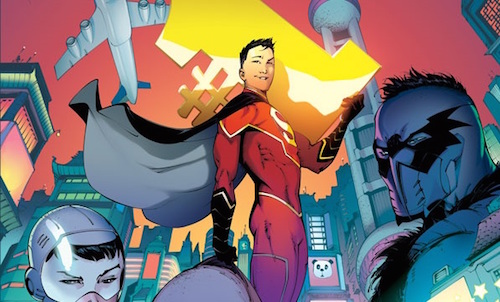Thursday Comics Hangover: The Super-Man of Shanghai

The thing about writing a Superman story, I remarked a few months ago after watching the dreadful Batman V Superman movie, is that the conflict should be based in exploring the concept of morality. All the superheroic trappings — the laser eyes, the flight, the strength — are basically just window-dressing. This is why Superman is a character who easily splinters into many different personalities: when the character famously died in the 1990s, he “returned” as four distinct characters, each with their own variation on the Superman theme, and each with their own spin on what it means to be a moral person.
The new DC Comics title New Super-Man is yet another variation on Superman, and it’s one of the best I’ve seen in quite some time. It doesn’t demand that you understand the internecine continuity of modern DC Comics, or really much of anything beyond the rudimentary idea of Superman. And the idea behind the series is deceptively simple: it takes the concept of Superman and transplants it to modern-day China.
Written by cartoonist Gene Luen Yang and penciled by Viktor Bogdanovic, New Super-Man is narrated by Kong Kenan, a young Chinese man. When we first meet him, Kenan is bullying a nerdy classmate and stealing his lunch. Through a coincidence that is probably more than a coincidence, Kenan is mistakenly labeled a hero. We meet his supporting cast including a nosy reporter named Laney Lan; Kenan’s father, a writer who is preparing to reveal a “secret government agency doing…evil stuff”; and a mysterious woman named Dr. Omen. One of the characters alludes to a slightly modified version of Superman’s credo — Truth, Justice, and rather than the American way, just plain old Democracy — and Kenan gets Superman’s powers.
So far as origin stories go, New Super-Man is not breaking new ground, but Yang manages to convey a lot of information in a small amount of space. This is obviously a book that is set in China, but it’s not over-the-top; no landmarks like the Great Wall of China are cartoonishly alluded to and nobody discusses their relationship with the United States. We’re told by a caption that all the dialogue we’re reading is translated from the Mandarin, with the exception of words printed in blue, which are spoken in English. It’s a full-immersion technique, and it works. This isn’t a book that could be set in Poughkeepsie. It’s very much of its time and place.
Bogdanovic’s art is more than a little stealthy: using some straightforward visual vocabulary like superhero anatomy and sci-fi elements, he relaxes readers who expect something traditional, but he sneaks in some extra exaggerations here and there — a ridiculously large gaping mouth, say, or some heavy shadow on a brooding Kenan’s face — to introduce a looser, more cartoony feel. The Shanghai in these pages might as well be a science-fiction city, the way Bogdanovic draws it, with its high-spire Jetsons architecture and the bright orange and turquoise palette provided by colorist Hi-Fi.
Because New Super-Man is so, uh, new, it’s hard to say exactly where Yang is going with all this. Will this be a political book? Is it a commentary on superheroes, or a relatively straightforward tribute to earnest heroics, like G. Willow Wilson’s Ms. Marvel? It really could go anywhere from here, which is exciting. The one theme that is absolutely clear from this first issue is that Yang is going to be using the character of Kenan to explore morality, both as a universal concept and what it means for the individual. In other words, it’s already apparent that it’s a very good Superman comic.